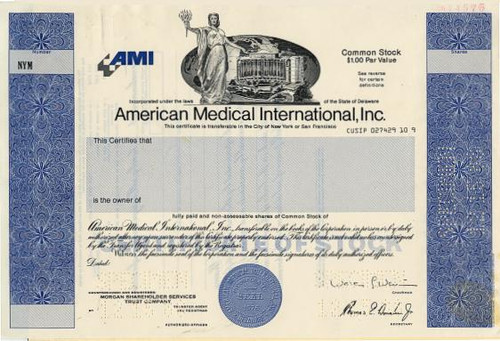Beautiful Specimen certificate from the International Bank for Reconstruction and Development. This historic document was printed by the American Banknote Company and has an ornate border around it with a vignette of the banks's name. This item has the signatures of the bank's President, and Senior Vice President, and is over 23 years old. 
Certificate Vignette The International Bank for Reconstruction and Development (IBRD) is one of five institutions that comprise the World Bank Group. The IBRD is an international organization whose original mission was to finance the reconstruction of nations devastated by World War II. Now, its mission has expanded to fight poverty by means of financing states. Its operation is maintained through payments as regulated by member states. It came into existence on December 27, 1945 following international ratification of the agreements reached at the United Nations Monetary and Financial Conference of July 1 to July 22, 1944 in Bretton Woods, New Hampshire. The IBRD provides loans to governments, and public enterprises, always with a government (or "sovereign") guarantee of repayment subject to general conditions (pdf). The funds for this lending come primarily from the issuing of World Bank bonds on the global capital markets--typically $1215 billion per year. These bonds are rated AAA (the highest possible) because they are backed by member states' share capital, as well as by borrowers' sovereign guarantees. (In addition, loans that are repaid are recycled, or relent.) Because of the IBRD's credit rating, it is able to borrow at relatively low interest rates. As most developing countries have considerably lower credit ratings, the IBRD can lend to countries at interest rates that are usually quite attractive to them, even after adding a small margin (about 1%) to cover administrative overheads. [edit] History Commencing operations on June 25, 1946, it approved its first loan on May 9, 1947 ($250m to France for postwar reconstruction, in real terms the largest loan issued by the Bank to date). The IBRD was established mainly as a vehicle for reconstruction of Europe and Japan after World War II, with an additional mandate to foster economic growth in developing countries in Africa, Asia and Latin America. Originally the bank focused mainly on large-scale infrastructure projects, building highways, airports, and powerplants. As Japan and its European client countries "graduated" (achieved certain levels of income per capita), the IBRD became focused entirely on developing countries. Since the early 1990s the IBRD has also provided financing to the post-Socialist states of Eastern Europe and the republics of the former Soviet Union. History from Wikipedia and OldCompany.com (old stock certificate research service).
About Specimen Certificates Specimen Certificates are actual certificates that have never been issued. They were usually kept by the printers in their permanent archives as their only example of a particular certificate. Sometimes you will see a hand stamp on the certificate that says "Do not remove from file". Specimens were also used to show prospective clients different types of certificate designs that were available. Specimen certificates are usually much scarcer than issued certificates. In fact, many times they are the only way to get a certificate for a particular company because the issued certificates were redeemed and destroyed. In a few instances, Specimen certificates were made for a company but were never used because a different design was chosen by the company. These certificates are normally stamped "Specimen" or they have small holes spelling the word specimen. Most of the time they don't have a serial number, or they have a serial number of 00000. This is an exciting sector of the hobby that has grown in popularity over the past several years.

Certificate Vignette
About Specimen Certificates Specimen Certificates are actual certificates that have never been issued. They were usually kept by the printers in their permanent archives as their only example of a particular certificate. Sometimes you will see a hand stamp on the certificate that says "Do not remove from file". Specimens were also used to show prospective clients different types of certificate designs that were available. Specimen certificates are usually much scarcer than issued certificates. In fact, many times they are the only way to get a certificate for a particular company because the issued certificates were redeemed and destroyed. In a few instances, Specimen certificates were made for a company but were never used because a different design was chosen by the company. These certificates are normally stamped "Specimen" or they have small holes spelling the word specimen. Most of the time they don't have a serial number, or they have a serial number of 00000. This is an exciting sector of the hobby that has grown in popularity over the past several years.








